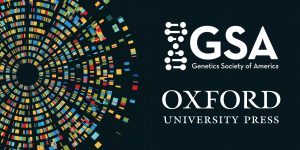Enter your address to receive notifications about new posts to your email.
Articles tagged G3 Journal
(248 results)
-
Naturally occurring small molecules correct mutant proteins in living cells
Yeast screens explore the therapeutic potential of chemical rescue. Anyone who’s worked in a lab knows that sinking feeling of discovering that the temperature of an incubator, carefully set the night before, has crept up high enough to ruin the experiment. While such a mishap usually spells disaster, occasionally, it can lead to an unexpected…
-
NUKUs: A new primate retrocopy family with distinct functionality
Multiple divergent retrocopies of the well-characterized Ku70 gene were identified in humans and other primates. The last 63 million years of primate evolution have been strongly shaped by genetic retrotransposition; thousands of genes and proteins with new functions have evolved from retrocopies scattered throughout the genome. These retrocopies arise when retrotransposons reverse transcribe a cellular…
-
Finding a happy medium boosts ChIP-seq data quality
Every lab wants to produce high-quality, reproducible data. But when that data is destined for use by the whole community as part of an international consortium, there is an even greater incentive to ensure the highest standards. A new paper in G3: Genes|Genomes|Genetics defines a critical step for the success of widely-used gene regulation experiments. …
-
New Senior Editors at GENETICS and G3
GENETICS and G3: Genes|Genomes|Genetics are pleased to announce two new Senior Editors; Sharon Browning is a Senior Editor at GENETICS, and Gustavo de los Campos is a Senior Editor at G3. GENETICS Sharon Browning Sharon Browning is a Professor of Biostatistics at the University of Washington. She received a BS in Mathematics from the University of…
-
The myrtle rust genome is the largest assembled fungal genome to date
Over 90 percent of the genome of this pathogen threatening Australian ecosystems is made of transposable elements. Myrtle rust (Austropuccinia psidii) is a pathogenic fungus that has spread rapidly across the globe with devastating effects on local vegetation, including agricultural crops. It is extremely versatile, with over 480 known host species in the widespread myrtle…
-
Welcome to new editors at G3 and GENETICS
GENETICS and G3: Genes | Genomes | Genetics are pleased to announce four new editors: Leah Cowen, Michael Goddard, Joseph Heitman, and Hongyu Zhao. GENETICS Leah Cowen Leah Cowen is Vice President of Research at the University of Toronto (UofT), Professor in the Department of Molecular Genetics, co-Director of the CIFAR Fungal Kingdom: Threats &…
-
Strawberry detectives retrace family roots
Geneticists dig up the dirt on 300 years of succulence. When Steve Knapp started his new job at the University of California, Davis, he plunged into a forensic mystery that would take years to unravel. He wasn’t hunting a criminal or identifying a missing person, but the challenge before him was just as formidable: reconstructing…
-
New Senior Editors joining GENETICS and G3
GENETICS and G3: Genes|Genomes|Genetics are pleased to announce two new Senior Editors: Meera Sundaram and Brian Oliver. GENETICS Meera Sundaram Meera Sundaram is a Professor of Genetics at the University of Pennsylvania Perelman School of Medicine. She received her BA in Biology from Mount Holyoke College and her PhD in Molecular Biology from Princeton University, and…
-
Peer Review Week 2020: Trust in Peer Review
As we wrap up Peer Review Week 2020, here’s a look at how the GSA journals help build trust in peer review. Our data availability policy means that reviewers and editors can really dig into the data during the review process—and that readers can access the data and build on it moving forward! Expert…
-
GENETICS and G3 welcome new editors
GENETICS and G3 are pleased to announce three new editors: Yasuhiko Kawakami, Amy Ralston, and Jordan Ward. GENETICS Yasuhiko Kawakami University of Minnesota I am interested in understanding the mechanisms that regulate specification, proliferation and patterning, leading to morphogenesis of functional tissues and organs. I use mice and zebrafish to study mechanisms of development of the…
-
Genetics Society of America partners with Oxford University Press to publish journals
Oxford University Press (OUP) and the Genetics Society of America (GSA) are pleased to announce that OUP will publish the GSA journals GENETICS and G3: Genes|Genomes|Genetics beginning January 2021. GENETICS is a peer-reviewed, peer-edited journal with an international reach and increasing visibility and impact. Since 1916, GENETICS has published high-quality, original research presenting novel findings…









